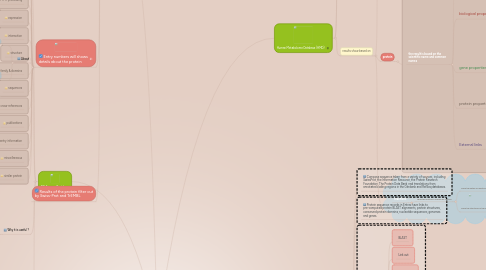
1. How NAR database has been organized
1.1. history
1.1.1. two supplementary issues
1.1.1.1. NAR (April 1991 & May 1992)- 18 and 19 articles
1.1.1.2. July 1,1993- first one formally labelled as Database Issue (24 articles)
1.2. 185 articles
1.2.1. descriptions of database resources at NCBI, European Bioinformatics Institute (EBI) and the US Department of Energy Joint Genome Institute (JGI)
1.2.2. 58 new molecular biology database
1.2.3. updated 100 databases previously featured in database
1.2.4. 23 databases that has been previously described in other journals
1.3. sections
1.3.1. nucleic acid sequence and structure, transcriptional regulation
1.3.2. protein sequence and structure, motifs and domains, protein-protein interactions
1.3.3. metabolic and signaling pathway, enzymes, protein modifications
1.3.4. viruses, bacteria, protozoa and fungi
1.3.5. human genome, model organism, comparative genomics
1.3.6. genomic variations, diseases and drugs
1.3.7. plant databases
1.3.8. other molecular biology database
1.4. Database collections
1.4.1. freely available at (http://www.oxfordjournals.org/nar/database/a/)
1.4.2. entire collection has been carefully curated by checking all non-responsive database website, coordination of such database has been asked to confirm their commitment to maintaining their resources
1.4.3. after changes, online collections
1.4.3.1. 1552 databases
1.4.3.1.1. 41 subcategories
1.4.3.1.2. 14 categories
2. EBI Enzyme Portal
2.1. Description
2.1.1. provide information of
2.1.1.1. human
2.1.1.2. yeast
2.1.1.3. some fruits
2.2. About
2.2.1. a portal of enzyme and protein with enzymatic activity
2.2.2. provide information about enzyme, small molecules, biological chemistry and drugs
2.3. Why it is useful ?
2.3.1. it provide
2.3.1.1. structure of protein
2.3.1.1.1. chains involved
2.3.1.1.2. bonds connecting the chains
2.3.1.2. function of protein
2.3.1.3. enzyme comission (EC) classification)
2.3.1.4. other names of the protein
2.3.1.5. protein sequence
2.3.1.6. description of proteins reactions and pathways
2.3.1.7. disease related to the protein
2.3.1.8. link to the referred journal
2.4. Sources
2.4.1. Uniprot
2.4.2. IntEnz
3. Uniprot
3.1. UniProt is the universal protein resource, a central repository of protein data created by combining the Swiss-Prot, TrEMBL and PIR-PSD databases.
3.1.1. UniProt consortium comprises the European Bioinformatics Institute (EBI), the Swiss Institute of Bioinformatics (SIB), and the Protein Information Resource (PIR).
3.1.2. Each consortium is heavily involved in protien database maintenance and conotation
3.2. UniProt provides four core databases: UniProtKB (with sub-parts Swiss-Prot and TrEMBL), UniParc, UniRef, and UniMes.
3.2.1. UniProtKB
3.2.2. UniParc
3.2.3. UniRef
3.2.4. UniMes
3.3. Shows results with the entry numbers, entry names, protein names, gene names and organisms.
3.4. Entry numbers will shows details about the protein
3.4.1. function
3.4.2. names and taxonomy
3.4.3. subcellular location
3.4.4. pathology & biotech
3.4.5. PTM / processing
3.4.6. expression
3.4.7. interaction
3.4.8. structure
3.4.9. family & domains
3.4.10. sequences
3.4.11. cross-references
3.4.12. publications
3.4.13. entry information
3.4.14. miscellaneous
3.4.15. similar protein
3.5. Results of the protein filter out by Swiss-Prot and TrEMBL
4. Human Metabolome Database (HMD)
4.1. show database which matched the keywords
4.2. detect keywords based on scientific names and common names
4.3. results show based on
4.3.1. metabolites
4.3.1.1. metabolites can be filter by the place that can be found
4.3.1.1.1. blood
4.3.1.1.2. urine
4.3.1.1.3. other fluids
4.3.2. protein
4.3.2.1. the result is based on the scientific name and common names
4.3.2.1.1. identification
4.3.2.1.2. biological properties
4.3.2.1.3. gene properties
4.3.2.1.4. protein properties
4.3.2.1.5. External links
4.3.3. reactions
4.3.3.1. show the reactions undergo by maltase
4.3.3.1.1. show the details of reactions
4.3.3.1.2. show the structures of the products
5. NCBI Protein Database
5.1. Compose sequence taken from a variety of sources, including SwissProt, the Information Resource, the Protein Research Foundation, The Protein Data Bank, nad translations from annotated coding regions in the Genbank and RefSeq databases.
5.2. Protein sequence records in Entrez have links to pre-computed protein BLAST alignments, protein structures, conserved protein domains, nucleotide sequences, genomes and genes.
5.3. Protein tools
5.3.1. BLAST
5.3.2. Link out
5.3.3. E-utilirities
5.3.4. Blink
5.3.5. Batch Entrez
5.4. other resources for information of the protein
5.4.1. GenBank home
5.4.2. RefSeq home
5.4.3. CDD
5.4.4. Strucuture
5.5. information of the protein ; filter out by
5.5.1. many species of organisms
5.5.1.1. animals
5.5.1.2. plants
5.5.1.3. protists
5.5.1.4. bacteria
5.5.1.5. archaea
5.5.1.6. fungi
5.6. the details of the species
5.6.1. the specific name, the genus, the family
5.6.2. the title of the journals and the information of the authors for researchs

